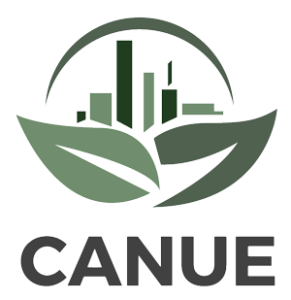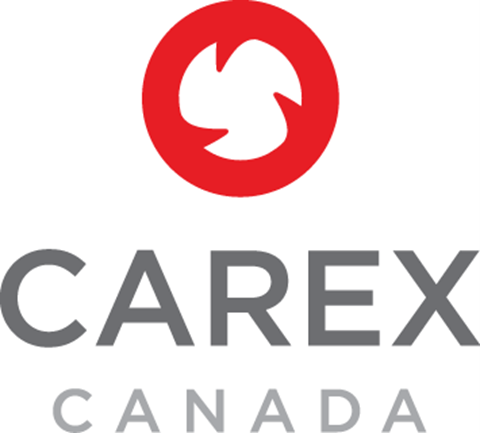Know Your Exposure: An Innovative App-based Approach to Exposure Assessment for Cancer Prevention
The Know Your Exposure (KYE) study has now closed. Thank you to those who participated in this study!
Study Information
Approximately 4 in 10 cancer cases are caused by things we can change. This includes things in our environment and where we work. Recent estimates say that 4,300 cancer cases happen because people spend too much time in the sun, 1,700 are because of a gas called radon in homes, and 1,700 more are because of air pollution. CAREX Canada has estimated that nearly 1.5 million Canadian workers are exposed to UV radiation at work, 150,000 to asbestos, 897,000 to diesel engine exhaust, and 382,000 workers are exposed to (crystalline) silica, which is very fine dust from rocks.
The use of mobile technology (apps) for conducting health interventions (mHealth) is a rapidly growing field, largely due to the widespread use of smartphones. mHealth interventions have targeted various areas related to physical activity, weight loss, and mental health, helping to increase knowledge, promote health education, and change health behaviours. To the best of our knowledge, there are only a few apps related to environmental carcinogens (cancer-causing agents), such as apps that track sun exposure.
The Know Your Exposure app will build on the HealthyDesign.city prototype tool (http://blog.healthyplan.city/), spearheaded by the Canadian Urban Environmental Health Research Consortium (CANUE), which tracks urban built environment determinants of health (e.g., air quality) based upon location. By bringing together powerful existing environmental and occupational data sources, CAREX Canada and CANUE, we are testing the Know Your Exposure app to see if it can help reduce exposure to cancer-causing agents in the environment and at work.
How many people will take part in this study?
We have invited 300 people, all of which are current participants in ATP.
How will your personal information be kept private?
If you decide to participate, you can expect that all communication about this study will be made through secure ATP channels or through the study team. You will be assigned a participant ID, and that ID is what you will use to access the app. ATP will be assigning participant IDs and at no time will the study team have access to your personal information associated with your participant ID.
Information collected through the app: The app will require access to your location, in order to use the tracking feature. When you choose to use the tracking feature, the app will use your location data to calculate an air pollution score. Once you finish using the tracking feature, an air pollution score will be recorded. No information, other than the final air pollution score, will be recorded. Your GPS coordinates will never be stored by the app on your phone or on any server.
Information collected through the surveys: No personal information will be collected through the surveys. The surveys will ask you basic information about how comfortable you are using mobile apps and how much you understand about your risk factors for cancer.
Are there any benefits to participation?
Participation in this study is voluntary and by participating in this study, you are helping us understand the current knowledge, attitudes, and behaviours about air pollution and occupational exposures related to cancer. Participating may also help you build awareness of your personal air pollution and occupational exposures.
Are there any risks to participation?
The risks of using our prototype app are similar to the risks associated with using any health-related app. We have identified an appropriate app developer with previous experience in health-related applications to help ensure the app is safe and secure. It is possible that you may feel discomfort (e.g., stress) due to an increased awareness of your exposure to air pollution and occupational carcinogens.
Will there be costs involved with participating in this study?
There are no out-of-pocket costs for you to participate in this study. You will however need to use a mobile device that has access to the internet. For the duration of the study period (2 weeks), depending on your use of the app, we anticipate that the app will use less than 100MB of data.
What are my rights as a participant in this study?
- You will be told, in a timely manner, about new information that may be relevant to your willingness to stay in this study.
- You have the right to be informed of the results of this study once the entire study is complete.
- Your rights to privacy are legally protected by federal and provincial laws that require safeguards to ensure that your privacy is respected.
- By signing this form you do not give up any of your legal rights against the researchers, institutions or their agents involved for compensation, nor does this form relieve these parties from their legal and professional responsibilities.
What will happen if I choose to withdraw from the study early?
If for any reason, you no longer wish to participate in the study, you may end your participation at any time. You can do this by notifying the study team. You are not required to remove the app from your phone or discontinue using the app. Information that was recorded before you withdraw will be used by the researcher for this study, but no additional information will be collected after you withdraw your permission.
You will remain a valued participant in ATP going forward.
Who do I contact for questions related to this study?
For more information you can contact ATP.
- Alberta’s Tomorrow Project (ATP), tomorrow@ahs.ca, 1-877-919-9292. Our call centre hours are Monday-Friday, 8:30am – 4:00pm MST.
If you have questions about your rights as a participant or about ethical issues related to this study and you would like to talk to someone who is not involved in the conduct of the study, please contact the Office of the Health Research Ethics Board of Alberta – Cancer Committee.
- Telephone: 780-423-5727
- Toll Free: 1-877-423-5727
KYE Application
Downloading the KYE app to your Android smartphone
- Participants in the KYE study will be emailed instructions how to download the KYE app. The app cannot be downloaded from this webpage. If you need this email resent, please contact us.
- Once the file has been downloaded to your phone, you will need to install the application. Using your file browser, find your downloads folder and select the file named KYEAPPV7.APK.
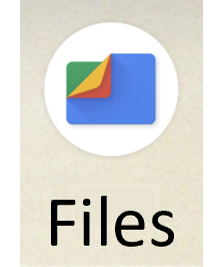
- Some phones may require you to grant permission to install applications from your file browser. If a prompt appears requesting permission to download, click “allow”.
- Next you will need to grant permission for the application to utilize some of the services on your phone. If you skip this step, you will not be able to use the GPS tracking feature.
Logging in to the KYE app for the first time
- Open the KYE app on your Android smartphone.
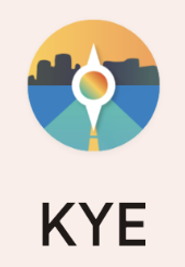
- At the welcome screen, enter your Participant ID. Your participant ID will be included in the same email as the app download instructions.
- There are three sections in the app (Occupational Exposure, Air Pollution Exposure and Track Me)
Occupation: Begin by typing in your occupation to see if you can find a match. If your exact occupation does not appear, enter in some similar search terms until you find a good match, or scroll through the list.
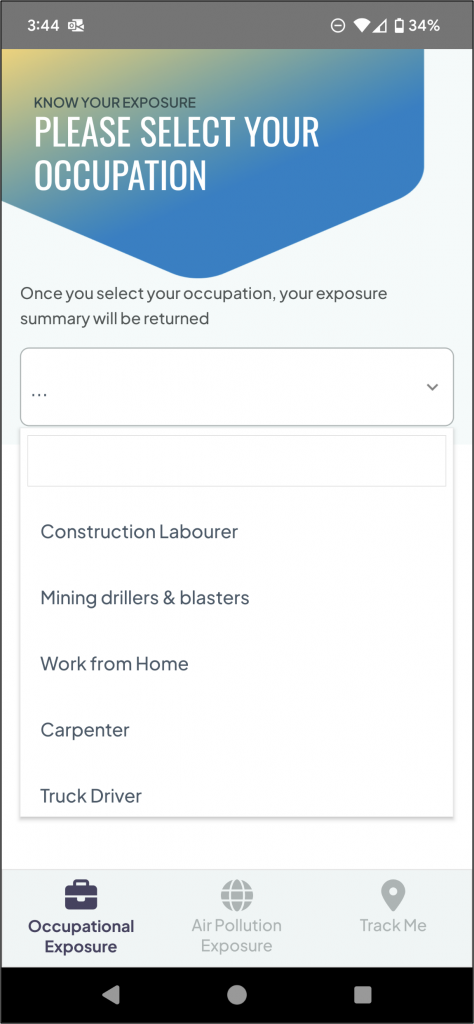
Air Pollution: Enter in your home address and work address. Your air pollution scores will be returned automatically. Click on “View Additional Information” to learn more about what the scores mean.
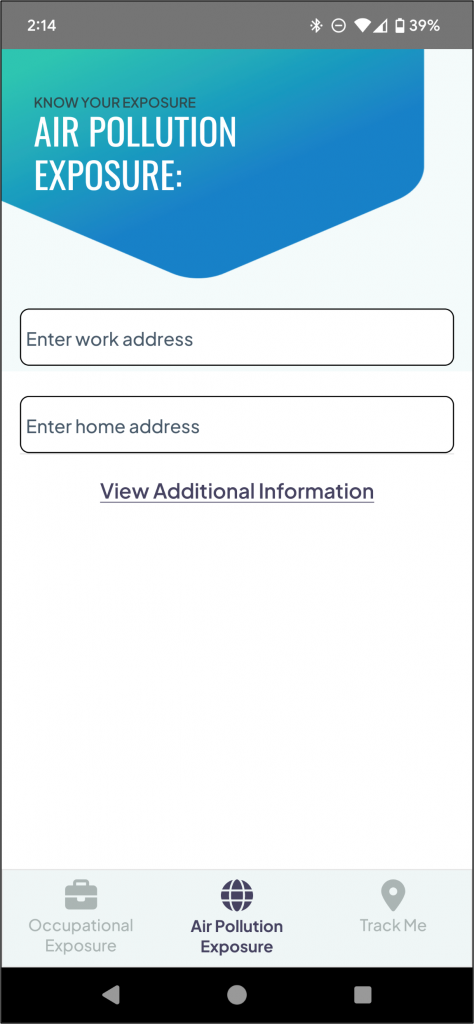
Track Me: Click “Track Me” to begin tracking and “Stop Tracking Me” to end the tracking session. Your score will be returned automatically and you may view scores from your past commutes. ***Before this feature is available, you will need to grant permissions (see next section). If you skip this step, you will not be able to use the GPS tracking feature.)
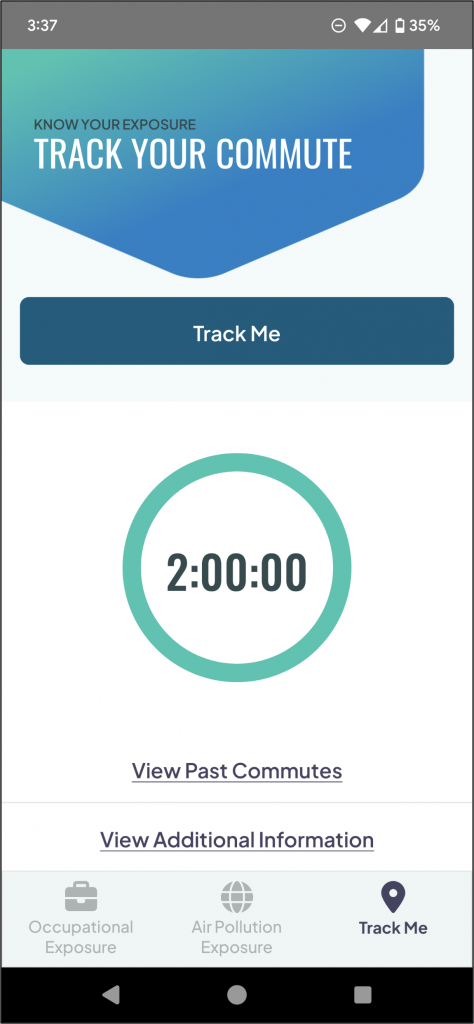
Granting permissions
You may be prompted to grant permissions to enable the KYE app to use certain services on your phone. The most common permissions are listed below; however your screen may appear differently than what is shown here.
- Access to device location
- Click “While using the app”

- Access to physical activity
- Click “Allow”

- Access to device location in the background
- Click “Allow all the time”

Guidelines for app use during the study period
- Occupational Exposures: You may look up your occupation and/or those of friends and family. Some occupations may return exposures that have links. Clicking those links will open up trusted webpages from the Canadian Centre for Occupational Health and Safety (CCOHS) and CAREX Canada. You may return to the app by pressing the back button at any time. Feel free to share what you learn.
- Air Pollution Exposure: You may enter your home and work address or addresses of friends and family. Feel free to share what you learn.
- Track Me: Work patterns vary. You may commute to a place of work, work primarily from home or a combination of the two. Here are some general guidelines that will establish a pattern, and allow you to notice any variation in returned NO2 scores. (Air pollution scores may change if you take different routes.)
| Work outside the home |
Work from home |
| To establish a good pattern, aim to use the app on your commute, each way, as many days as possible over a two-week period. | When traveling to places outside your home, aim to use the app for one outing (to and from), as many days as possible over a two-week period. |
Questions or Concerns?
If you have any difficulties downloading or using the app please contact us at tomorrow@ahs.ca or call us at 1-877-919-9292 to talk to us directly. Our call centre hours are Monday-Friday, 8:30am – 4:00pm MST.
Frequently Asked Questions
Please visit the KYE Frequently Asked Questions page here for additional information: myatp.ca/kye-faqs
Every worker has the right to a safe work environment
For more information related to the health and safety of workers, please visit the Canadian Centre for Occupational Health and Safety www.ccohs.ca/topics/workers
Occupational Exposures
Below are links to information about the occupational exposures you may have come across in the KYE app, sorted by exposure type (hazardous substances (primarily chemical), biological, physical and radiation & psychosocial)
Hazardous substances:
- Antineoplastics: https://creod.on.ca/antineoplastic-drugs/
- Arsenic: https://www.carexcanada.ca/profile/arsenic/
- Asbestos: https://www.ccohs.ca/oshanswers/chemicals/asbestos/
- Benzene: https://www.ccohs.ca/oshanswers/chemicals/chem_profiles/benzene.html
- Cadmium: https://www.carexcanada.ca/profile/cadmium/
- Chromium: https://www.carexcanada.ca/profile/chromium_hexavalent/
- Coal tar and coal-tar pitches: https://www.carexcanada.ca/profile/coal_tar_and_coal-tar_pitches/
- Creosotes: https://www.carexcanada.ca/profile/creosotes/
- Diesel Engine Exhaust: https://www.ccohs.ca/oshanswers/chemicals/diesel_exhaust.html
- Ethylbenzene: https://www.carexcanada.ca/profile/ethylbenzene/
- Formaldehyde: https://www.ccohs.ca/oshanswers/chemicals/chem_profiles/formaldehyde.html
- Gasoline engine exhaust: https://www.carexcanada.ca/profile/gasoline_engine_exhaust/
- Lead: https://www.ccohs.ca/oshanswers/chemicals/chem_profiles/lead.html
- Indoor air quality: https://www.ccohs.ca/topics/hazards/physical/iaq/
- Outdoor air pollution: https://www.carexcanada.ca/profile/outdoor_air_pollution/
- Polycyclic aromatic hydrocarbons: https://www.carexcanada.ca/profile/polycyclic_aromatic_hydrocarbons/
- Second-hand smoke: https://www.carexcanada.ca/profile/second_hand_smoke/
- Silica: https://www.ccohs.ca/oshanswers/chemicals/chem_profiles/quartz_silica.html
- Welding Fumes: https://www.carexcanada.ca/profile/welding-fumes/
- Wood dust: https://www.ccohs.ca/oshanswers/chemicals/wood_dust.html
Biological hazards:
- Avian Influenza: https://www.ccohs.ca/oshanswers/diseases/avian_influenza.html
- COVID-19: https://www.ccohs.ca/oshanswers/diseases/coronavirus.html
- Influenza: https://www.ccohs.ca/oshanswers/diseases/pandemic_flu.html
- Zika Virus: https://www.ccohs.ca/oshanswers/diseases/zika_virus.html
Physical and radiation hazards:
- Ergonomics: https://www.ccohs.ca/oshanswers/ergonomics/
- Extreme heat and cold: https://www.ccohs.ca/topics/hazards/physical/temperature/
- Ionizing radiation: https://www.carexcanada.ca/profile/ionizing_radiation/
- Noise: https://www.ccohs.ca/topics/hazards/physical/noise/
- Radiation: https://www.ccohs.ca/topics/hazards/physical/radiation/
- Radon: https://www.ccohs.ca/oshanswers/phys_agents/radon.html
- Skin health: https://creod.on.ca/occupational-skin-disease/skin-health-toolbox/
- Vibration: https://creod.on.ca/havs/
- UV Radiation (artificial & solar): https://www.ccohs.ca/oshanswers/phys_agents/ultravioletradiation.html
Psychosocial hazards:
- Fatigue: https://www.ccohs.ca/oshanswers/psychosocial/fatigue.html
- Job burnout: https://www.ccohs.ca/oshanswers/psychosocial/mh/mentalhealth_jobburnout.html
- Nigh shift work: https://www.carexcanada.ca/profile/shiftwork/
- Stigma: https://www.ccohs.ca/oshanswers/psychosocial/mh/mentalhealth_stigma.html
- Work-life balance: https://www.ccohs.ca/oshanswers/psychosocial/worklife_balance.html
- Workplace stress: https://www.ccohs.ca/oshanswers/psychosocial/stress.html
- Workplace violence and bullying: https://www.ccohs.ca/topics/hazards/psychosocial/violence/
Air pollution exposure
For more detailed information about air pollution in your area, please view the interactive map available here: https://healthyplan.city/en

Cancer and the workplace
For more information related to occupational cancers, please visit: https://www.ccohs.ca/oshanswers/diseases/cancer/occupational_cancer.html
Cancer sites associated with occupational exposures: https://www.ccohs.ca/oshanswers/diseases/cancer/carcinogen_site.html
Glossary
1,3-Butadiene: A by-product of incomplete combustion of organic matter; produced commercially for industrial use
Acetaldehyde: Acetaldehyde is a colourless and volatile liquid that is widely used industrially as a chemical intermediate
Acrylamide: Acrylamide is a colourless or white crystalline powder used as an intermediary in producing polyacrylamide and acrylamide copolymers
Antineoplastic agents: A group of drugs that are used to treat various cancers
Arsenic: A naturally occurring semi-metallic element found in complex mineral deposits
Asbestos: A group of naturally occurring, fibrous silicate minerals
Cadmium: A soft metal found in mineral deposits with lead, zinc, and copper
CANUE: The Canadian Urban Environmental Health Research Consortium (CANUE) is a consortium made up of voluntary members from the multi-disciplinary fields of environmental health research, health policy, and urban design and planning www.canue.ca
CAREX Canada: CAREX Canada (CARcinogen EXposure) is a multi-institution team of researchers and specialists with expertise in epidemiology, exposure assessment, spatial analysis, health policy, and knowledge mobilization www.carexcanada.ca
Carcinogen: An organism, agent or substance that promotes the formation of cancer
Chloroform: A colourless, volatile liquid with an ethereal odour
Chromium: A naturally occurring element in the earth’s crust, and a product of industrial processes
Coal tar and coal-tar pitches: A by-product of coke or gas production from carbonized coal
Cobalt: A naturally-occurring, silvery-grey magnetic metal with properties similar to iron and nickel
Creosotes: Complex and variable mixtures made from distilled coal
Dichloromethane: A volatile, clear, and colourless liquid with a smell similar to chloroform
Diesel Engine Exhaust: A complex mixture of gases and particulates produced from the combustion of diesel fuel in engines
Ethylbenzene: A volatile organic compound (VOC) in the ‘BTEX’ substance group which includes benzene, toluene, ethylbenzene, and xylene
Exposure: The state of being exposed to something
Formaldehyde: A flammable, colourless gas with a pungent odour
Gasoline Engine Exhaust: A complex mixture of gases and particulate matter produced when gasoline fuel combusts
Ionizing Radiation: Particles or rays emitted by natural and artificial radioactive materials, nuclear reactions, and radiation producing machines
Lead: A soft, highly malleable, and ductile metal that is insoluble in water; forms both organic and inorganic compounds
mHealth apps: MHealth apps are mobile device applications intended to improve health outcomes, facilitate health research and/or deliver health care services. Types of mHealth apps include: remote monitoring, healthy living, disease management, symptom checking, and clinical and diagnostic apps
Naphthalene: A polycyclic aromatic hydrocarbon (PAH), may exist as white crystalline plates, balls, or powder, and has a distinctive mothball odour
Nickel: A silvery, hard metal or gray powder not commonly found in nature
Night Shift Work: Work time organized to cover more than the usual 8-hour workday, up to a 24-hour period
NO2: Nitrogen Dioxide is a chemical compound found in the air, primarily as a result of burning fuel
Occupational Hygiene: A branch of occupational health and safety that focuses on the prevention of occupational diseases
OEL: Occupational Exposure Limits indicate the level of permissible exposure, for a given length of time, to a chemical or physical hazard, that is not likely to affect the health of the worker
Outdoor Air Pollution: A mixture of pollutants formed during various natural and man-made processes
Polycyclic Aromatic Hydrocarbons (PAHs): A group of over 100 chemicals formed during the incomplete burning of coal, oil, gas, wood, garbage, and other organic substances
Pentachlorophenol: A pesticide used in industrial wood preservation
PPM: Parts Per Million
PM2.5: Fine particulate matter that is equal to or less than 2.5 microns in diameter
Radon: A naturally occurring radioactive gas produced when uranium in soils and rocks breaks down
Second-Hand Smoke: A mixture of tobacco smoke and ambient air
Silica (Crystalline): One of the most common minerals on earth and a basic component of soil, sand, and rocks
Tetrachloroethylene: A colourless, volatile liquid with an ether-like odour used as a chlorinated solvent
Toluene Diisocyanates: Colourless to pale yellow liquids, solids, or crystals with a distinctive and pungent odour widely used to manufacture polyurethane foams and coatings
UV Artificial Radiation: Radiation emitted by artificial sources, found between visible light and x-rays on the electromagnetic spectrum
UV Solar Radiation: Radiation from the sun between wavelengths of 100 and 400 nanometres on the electromagnetic spectrum
Welding Fumes: A complex mixture of fine particles and gases produced as a byproduct of welding activities
Wood Dust: A by-product of logs being converted into finished wood products
WHMIS: Workplace Hazardous Materials Information System

